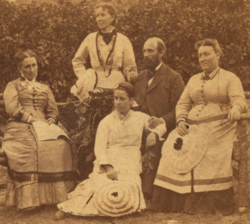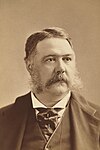Edmunds Act
 | |
| Other short titles | Anti-Plural Marriage Act of 1882 |
|---|---|
| Long title | An Act to amend section fifty-three hundred and fifty-two of the Revised Statutes of the United States, in reference to bigamy, and for other purposes. |
| Nicknames | Anti-Polygamy Act of 1882 |
| Enacted by | the 47th United States Congress |
| Effective | March 22, 1882 |
| Citations | |
| Public law | 47-47 |
| Statutes at Large | 22 Stat. 30b |
| Legislative history | |
| |
| Mormonism and polygamy |
|---|
 A Mormon "Saint" and Wives by Charles Weitfle (ca.1878–1885) |
| Early Mormonism Joseph Smith • Wives of Joseph Smith • Origin of Latter Day Saint polygamy • Spiritual wifery |
| Brigham Young • Wives of Brigham Young • Late-19th century Mormon polygamy • Mormon colonies in Mexico • 1890 Manifesto • Reed Smoot hearings • 1904 Manifesto |
| AUB • Centennial Park group • Council of Friends • Current state of polygamy • FLDS Church • Kingston Group • List of leaders • Lost boys • Short Creek raid • YFZ Ranch |
| Antipolygamy laws |
| Case law Reynolds v. US • Cannon v. US • Clawson v. US • Davis v. Beason • Late Corp. of the LDS Church v. US • Cleveland v. US • Brown v. Buhman • List of polygamy court cases |
 Latter Day Saints portal Latter Day Saints portal |
|
The Edmunds Act, also known as the Edmunds Anti-Polygamy Act of 1882,[1] is a United States federal statute, signed into law on March 23, 1882 by President Chester A. Arthur, declaring polygamy a felony in federal territories, punishable by "a fine of not more than five hundred dollars and by imprisonment for a term of not more than five years".[2] The act is named for U.S. Senator George F. Edmunds of Vermont. The Edmunds Act also prohibited "bigamous" or "unlawful cohabitation" (a misdemeanor),[3] thus removing the need to prove that actual marriages had occurred.[1] The act not only reinforced the 1862 Morrill Anti-Bigamy Act but also made the offense of unlawful cohabitation much easier to prove than polygamy misdemeanor and made it illegal for polygamists or cohabitants to vote, hold public office, or serve on juries in federal territories.[4]
A claim was made that the law violated the constitutional prohibition on ex post facto laws; that is, polygamists were charged for polygamist marriages solemnized before the passage of the statute. A challenge to the statute was framed on these and other grounds. The Supreme Court ruled, in Murphy v. Ramsey, 114 U.S. 15 (1885), that the statute was not ex post facto because convicts were charged for their continued cohabitation, not for the prior illegal marriage.[5] Some modern scholars suggest the law may be unconstitutional for violating the Free Exercise Clause.[6]
The Edmunds Act restrictions were enforced regardless of whether an individual was actually practicing polygamy, or merely stated a belief in the doctrine of the Church of Jesus Christ of Latter-day Saints (LDS Church) on plural marriage without actually participating. It also provided for a five-man Utah Commission appointed by the president to supervise all aspects of the electoral process in Utah Territory.[4] All elected offices throughout the territory were vacated; the election board issued certificates to candidates who both denied a belief in polygamy and did not practice it; and new elections were held.
Enforcement of the acts started in July 1887. The issue went to the U.S. Supreme Court in the case Late Corp. of the Church of Jesus Christ of Latter-Day Saints v. United States, which upheld the Edmunds–Tucker Act on May 19, 1890. Among other things, the act disincorporated the LDS Church. Within five months, the LDS Church officially discontinued the practice of plural marriage with the 1890 Manifesto. On October 25, 1893, a congressional resolution authorized the release of assets seized from the LDS Church because, "said the church has discontinued the practice of polygamy and no longer encourages or gives countenance to any manner of practices in violation of law, or contrary to good morals or public policy."[7]
Convictions

More than 1,300 men were imprisoned under the terms of the Edmunds Act.[1] It appears that women were not prosecuted, being seen as victims of the practice and not willing participants, although a number refused to testify against their husbands and some were jailed for their refusal.[3]
- Rudger Clawson — August 1882 — a member of the Quorum of the Twelve Apostles who was the first person convicted. He was pardoned by President Grover Cleveland mere months before his sentence was to expire.[8]
- William J. Flake — 1883 — one of the founders of Snowflake, Arizona, who married his second wife in 1868. Was imprisoned in the Yuma Territorial Prison in 1883. After his release, when asked which of his wives he was going to give up, he replied, "Neither. I married both in good faith and intended to support both of them." As he had already served his sentence, he could not be retried on the same charges.[citation needed]
- Angus M. Cannon — 1885 — a stake president, member of the Council of Fifty, and younger brother of apostle George Q. Cannon. Cannon was sentenced to six months imprisonment and a $900 fine.[9] Cannon was the appellant in the case of Cannon v. United States, which was decided by the Supreme Court in 1885.[10] Cannon's appeal was because he had immediately ceased having sexual relations with the two wives he was accused of cohabiting with after polygamy was criminalized.[10] The Court rejected Cannon's argument, holding that "[c]ompacts for sexual non-intercourse, easily made and easily broken, when the prior marriage relations continue to exist, with the occupation of the same house and table and the keeping up of the same family unity, is not a lawful substitute for the monogamous family which alone the statute tolerates."[10]
- John Sharp — 1885 — a bishop, member of the Council of Fifty, territorial chairman of the People's Party, director for the Union Pacific Railroad, Zion's Cooperative Mercantile Institution, Deseret Telegraph, and Deseret National Bank. Sharp initially pled not guilty, but withdrew his plea and pled guilty to the charge.[11] He was fined $300 and court costs.[11] As a result of pleading guilty, rather than plead not guilty as other LDS Church leaders had done, Sharp was asked by the stake high council and the First Presidency to resign as bishop of the Salt Lake Twentieth Ward, which he did on 3 November 1885.[12] The New York Times criticized the church's removal of Sharp and suggested that it "reveals again the stubborn character of the Mormons' opposition to the law".[13]
- Lorenzo Snow — 1885 — a church apostle at the time. In late 1885, Snow was indicted by a federal grand jury for three counts of unlawful cohabitation. According to his indictments, Snow had lived with more than one woman for three years. The jury delivered one indictment for each of these years, and Snow was convicted on each count. After conviction, he filed a petition for writ of habeas corpus in the federal district court which convicted him. The petition was denied, but federal law guaranteed him an appeal to the Supreme Court. In Ex Parte Snow,[14] the Supreme Court invalidated Snow's second and third convictions for unlawful cohabitation. It found that unlawful cohabitation was a "continuing offense," and thus that Snow was at most guilty of one such offense for cohabiting continuously with more than one woman for three years. Snow became president of the LDS Church in 1898.
- Abraham H. Cannon — 1886 — a member of the First Council of the Seventy and son of apostle George Q. Cannon. Cannon was convicted of unlawful cohabitation in 1886 and sentenced to six months' imprisonment, which he served in full. In 1889 he became a church apostle.[citation needed]
- David John — 1887 — Provo stakeholder and Vice President of the Brigham Young University Board of Trustees. John married a second wife, Jane Cree, in 1865. He had nine children with Mary and 11 children with Jane. In 1887, he spent time in prison for violating the Edmunds Act.
- George Q. Cannon — 1888 — a church apostle and former non-voting delegate for the Utah Territory in the United States Congress, before the passage of the Edmunds Act. Cannon surrendered himself to authorities and pled guilty at trial to a charge of unlawful cohabitation. As a result, Cannon served nearly six months in Utah's federal penitentiary.[15]
- Heber J. Grant — 1899 — a church apostle at the time. Grant pleaded guilty to unlawful cohabitation and paid a $100 fine.[16] Grant became president of the LDS Church in 1918.
- Joseph F. Smith — 1906 — LDS Church president. Smith was brought to trial on a charge of unlawful cohabitation with four women in addition to his lawful wife; he pled guilty and was fined $300, the maximum penalty then permitted under the law.[17]
See also
- Utah War (1857–1858)
- Poland Act (1874)
- Reynolds v. United States (1879)
- Smoot Hearings (1903–1907)
- Second Manifesto (1904)
- History of civil marriage in the U.S.
- Cohabitation in the United States
- Zion's Central Board of Trade
References
- ^ a b c U.S.History.com, Edmunds Anti-Polygamy Act of 1882.
- ^ ""The Edmunds Act"" (PDF). Library of Congress. 1882
- ^ a b About Mormons, Anti-Polygamy Legislation. Accessed 2008.03.26.
- ^ a b Thatcher, Linda (ed.). "Struggle For Statehood Chronology". State of Utah. Archived from the original on April 20, 2016. Retrieved February 15, 2017.
- ^ See also "The Anti-Polygamy Law; Its Constitutionality Upheld by the Supreme Court", The New York Times, March 24, 1885, p. 3.
- ^ Vazquez, Richard A. (Fall 2001), "The Practice of Polygamy: Legitimate Free Exercise of Religion or Legitimate Public Menace? Revising Reynolds in Light of Modern Constitutional Jurisprudence" (PDF), New York University Journal of Legislation and Public Policy, 5 (1), New York University School of Law: 225–253, archived from the original (PDF) on 2014-02-28, retrieved 2014-02-24
- ^ Jt. Res 11., 53d Cong., 1st Sess., 28 Stat. 980
- ^ Whittaker, David J. “Prisoner for Polygamy: The Memoirs and Letters of Rudger Clawson at the Utah Territorial Penitentiary, 1884–87. Edited by Stan Larson. Urbana, Ill.: University of Illinois Press, 1993.
- ^ "The Anti-Polygamy Law; Ex-Delegate Cannon's Sentence Affirmed. The Supreme Court Upholds the Decisions of the Territorial Judges; Opinions in Other Cases", The New York Times, 1885-12-15.
- ^ a b c 116 U.S. 55 (1885).
- ^ a b "Mormon Bishop Sharp.; He Tells About His Plural Marriages, Pleads Guilty, and is Fined", The New York Times, 1885-09-25, p. 5.
- ^ J. Max Anderson (1979). The Polygamy Story: Fiction and Fact (Salt Lake City, Utah: Publishers Press) ch. 2.
- ^ "A Mormon Bishop Deposed", The New York Times, 1886-09-05, p. 6.
- ^ 120 U.S. 274 (1887)
- ^ Cannon, Joseph A.; Fish, Rick (1994), "Cannon, George Q.", in Powell, Allan Kent (ed.), Utah History Encyclopedia, Salt Lake City, Utah: University of Utah Press, ISBN 0874804256, OCLC 30473917, archived from the original on 2017-01-13, retrieved 2013-10-30
- ^ Salt Lake Daily Tribune, 1899-09-09.
- ^ Deseret Evening News, November 23, 1906; Salt Lake Tribune, November 24, 1906.
Further reading
- "Gospel Topics: The Manifesto and the End of Plural Marriage", churchofjesuschrist.org, LDS Church, retrieved 2014-10-22
- Peters, Gerhard; Woolley, John T. "Chester A. Arthur: "First Annual Message," December 6, 1881". The American Presidency Project. University of California - Santa Barbara. Archived from the original on April 24, 2016. Retrieved April 9, 2016.
- Peters, Gerhard; Woolley, John T. "Chester A. Arthur: "Special Message," April 3, 1882". The American Presidency Project. University of California - Santa Barbara. Archived from the original on April 24, 2016. Retrieved April 9, 2016.













